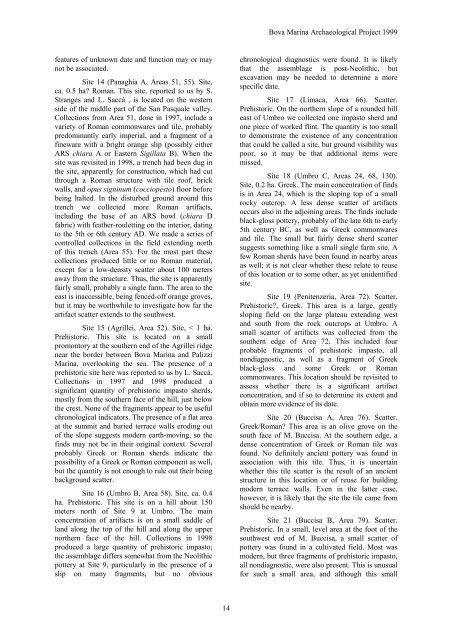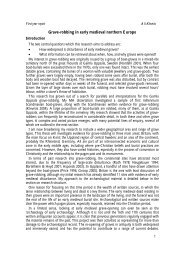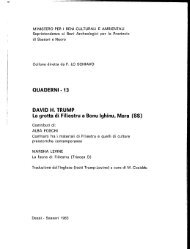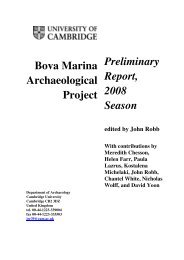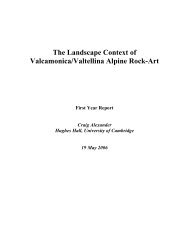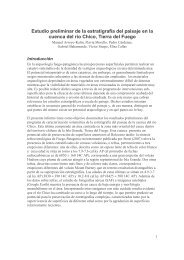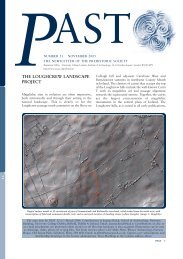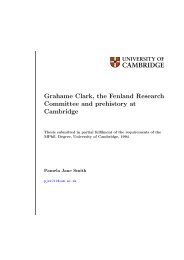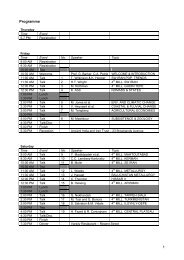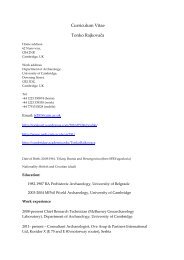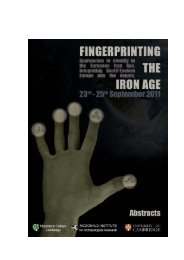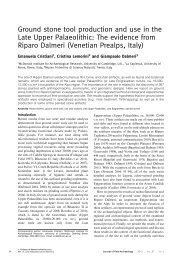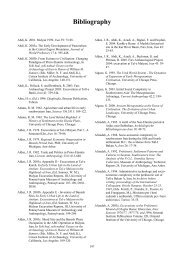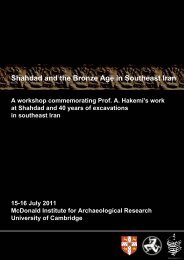Bova Marina Archaeological Project - Department of Archaeology
Bova Marina Archaeological Project - Department of Archaeology
Bova Marina Archaeological Project - Department of Archaeology
You also want an ePaper? Increase the reach of your titles
YUMPU automatically turns print PDFs into web optimized ePapers that Google loves.
features <strong>of</strong> unknown date and function may or may<br />
not be associated.<br />
Site 14 (Panaghia A, Areas 51, 55). Site,<br />
ca. 0.5 ha? Roman. This site, reported to us by S.<br />
Stranges and L. Saccà , is located on the western<br />
side <strong>of</strong> the middle part <strong>of</strong> the San Pasquale valley.<br />
Collections from Area 51, done in 1997, include a<br />
variety <strong>of</strong> Roman commonwares and tile, probably<br />
predominantly early imperial, and a fragment <strong>of</strong> a<br />
fineware with a bright orange slip (possibly either<br />
ARS chiara A or Eastern Sigillata B). When the<br />
site was revisited in 1998, a trench had been dug in<br />
the site, apparently for construction, which had cut<br />
through a Roman structure with tile ro<strong>of</strong>, brick<br />
walls, and opus signinum (cocciopesto) floor before<br />
being halted. In the disturbed ground around this<br />
trench we collected more Roman artifacts,<br />
including the base <strong>of</strong> an ARS bowl (chiara D<br />
fabric) with feather-rouletting on the interior, dating<br />
to the 5th or 6th century AD. We made a series <strong>of</strong><br />
controlled collections in the field extending north<br />
<strong>of</strong> this trench (Area 55). For the most part these<br />
collections produced little or no Roman material,<br />
except for a low-density scatter about 100 meters<br />
away from the structure. Thus, the site is apparently<br />
fairly small, probably a single farm. The area to the<br />
east is inaccessible, being fenced-<strong>of</strong>f orange groves,<br />
but it may be worthwhile to investigate how far the<br />
artifact scatter extends to the southwest.<br />
Site 15 (Agrillei, Area 52). Site, < 1 ha.<br />
Prehistoric. This site is located on a small<br />
promontory at the southern end <strong>of</strong> the Agrillei ridge<br />
near the border between <strong>Bova</strong> <strong>Marina</strong> and Palizzi<br />
<strong>Marina</strong>, overlooking the sea. The presence <strong>of</strong> a<br />
prehistoric site here was reported to us by L. Saccà.<br />
Collections in 1997 and 1998 produced a<br />
significant quantity <strong>of</strong> prehistoric impasto sherds,<br />
mostly from the southern face <strong>of</strong> the hill, just below<br />
the crest. None <strong>of</strong> the fragments appear to be useful<br />
chronological indicators. The presence <strong>of</strong> a flat area<br />
at the summit and buried terrace walls eroding out<br />
<strong>of</strong> the slope suggests modern earth-moving, so the<br />
finds may not be in their original context. Several<br />
probably Greek or Roman sherds indicate the<br />
possibility <strong>of</strong> a Greek or Roman component as well,<br />
but the quantity is not enough to rule out their being<br />
background scatter.<br />
Site 16 (Umbro B, Area 58). Site, ca. 0.4<br />
ha. Prehistoric. This site is on a hill about 150<br />
meters north <strong>of</strong> Site 9 at Umbro. The main<br />
concentration <strong>of</strong> artifacts is on a small saddle <strong>of</strong><br />
land along the top <strong>of</strong> the hill and along the upper<br />
northern face <strong>of</strong> the hill. Collections in 1998<br />
produced a large quantity <strong>of</strong> prehistoric impasto;<br />
the assemblage differs somewhat from the Neolithic<br />
pottery at Site 9, particularly in the presence <strong>of</strong> a<br />
slip on many fragments, but no obvious<br />
14<br />
<strong>Bova</strong> <strong>Marina</strong> <strong>Archaeological</strong> <strong>Project</strong> 1999<br />
chronological diagnostics were found. It is likely<br />
that the assemblage is post-Neolithic, but<br />
excavation may be needed to determine a more<br />
specific date.<br />
Site 17 (Limaca, Area 66). Scatter.<br />
Prehistoric. On the northern slope <strong>of</strong> a rounded hill<br />
east <strong>of</strong> Umbro we collected one impasto sherd and<br />
one piece <strong>of</strong> worked flint. The quantity is too small<br />
to demonstrate the existence <strong>of</strong> any concentration<br />
that could be called a site, but ground visibility was<br />
poor, so it may be that additional items were<br />
missed.<br />
Site 18 (Umbro C, Areas 24, 68, 130).<br />
Site, 0.2 ha. Greek. The main concentration <strong>of</strong> finds<br />
is in Area 24, which is the sloping top <strong>of</strong> a small<br />
rocky outcrop. A less dense scatter <strong>of</strong> artifacts<br />
occurs also in the adjoining areas. The finds include<br />
black-gloss pottery, probably <strong>of</strong> the late 6th to early<br />
5th century BC, as well as Greek commonwares<br />
and tile. The small but fairly dense sherd scatter<br />
suggests something like a small single farm site. A<br />
few Roman sherds have been found in nearby areas<br />
as well; it is not clear whether these relate to reuse<br />
<strong>of</strong> this location or to some other, as yet unidentified<br />
site.<br />
Site 19 (Penitenzeria, Area 72). Scatter.<br />
Prehistoric?, Greek. This area is a large, gently<br />
sloping field on the large plateau extending west<br />
and south from the rock outcrops at Umbro. A<br />
small scatter <strong>of</strong> artifacts was collected from the<br />
southern edge <strong>of</strong> Area 72. This included four<br />
probable fragments <strong>of</strong> prehistoric impasto, all<br />
nondiagnostic, as well as a fragment <strong>of</strong> Greek<br />
black-gloss and some Greek or Roman<br />
commonwares. This location should be revisited to<br />
assess whether there is a significant artifact<br />
concentration, and if so to determine its extent and<br />
obtain more evidence <strong>of</strong> its date.<br />
Site 20 (Buccisa A, Area 76). Scatter.<br />
Greek/Roman? This area is an olive grove on the<br />
south face <strong>of</strong> M. Buccisa. At the southern edge, a<br />
dense concentration <strong>of</strong> Greek or Roman tile was<br />
found. No definitely ancient pottery was found in<br />
association with this tile. Thus, it is uncertain<br />
whether this tile scatter is the result <strong>of</strong> an ancient<br />
structure in this location or <strong>of</strong> reuse for building<br />
modern terrace walls. Even in the latter case,<br />
however, it is likely that the site the tile came from<br />
should be nearby.<br />
Site 21 (Buccisa B, Area 79). Scatter.<br />
Prehistoric. In a small, level area at the foot <strong>of</strong> the<br />
southwest end <strong>of</strong> M. Buccisa, a small scatter <strong>of</strong><br />
pottery was found in a cultivated field. Most was<br />
modern, but three fragments <strong>of</strong> prehistoric impasto,<br />
all nondiagnostic, were also present. This is unusual<br />
for such a small area, and although this small


